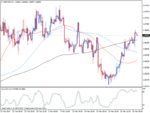CapitalTrustMarkets
Member
- Messages
- 76
- Likes
- 0
Daily Gold Technical Outlook

Technical outlook and chart setups:
1. Gold has been moving as per expectations for now. It has paused at $1,310.00 for the moment, breaking down the line of support as seen here. A sharp rally is expected into the $1,360.00/70.00 region from here on, before reversing lower. It is recommended to go initiate short positions between $1,360.00/65.00. Risk remains at $1,388.00.
2. Immediate support is at $1,230.00/40.00, followed by $1,210.00 and $1,180.00, while resistance is at $1,360.00 (the Fibonacci 0.618 of the fall from $1,388.00 to $1,310.00), and followed by $1,388.00 respectively.
3. The structure reveals that Gold is poised to fall into the $1,250.00 region in a corrective counter trend from here on. Trading opportunities are to go short first around $1,360.00 mark and then long around $1,258.00.
Trading recommendations:
Sell between $1,358.00/$1,362.00, stop at $1,388.00, and target $1,260.00.

Technical outlook and chart setups:
1. Gold has been moving as per expectations for now. It has paused at $1,310.00 for the moment, breaking down the line of support as seen here. A sharp rally is expected into the $1,360.00/70.00 region from here on, before reversing lower. It is recommended to go initiate short positions between $1,360.00/65.00. Risk remains at $1,388.00.
2. Immediate support is at $1,230.00/40.00, followed by $1,210.00 and $1,180.00, while resistance is at $1,360.00 (the Fibonacci 0.618 of the fall from $1,388.00 to $1,310.00), and followed by $1,388.00 respectively.
3. The structure reveals that Gold is poised to fall into the $1,250.00 region in a corrective counter trend from here on. Trading opportunities are to go short first around $1,360.00 mark and then long around $1,258.00.
Trading recommendations:
Sell between $1,358.00/$1,362.00, stop at $1,388.00, and target $1,260.00.












